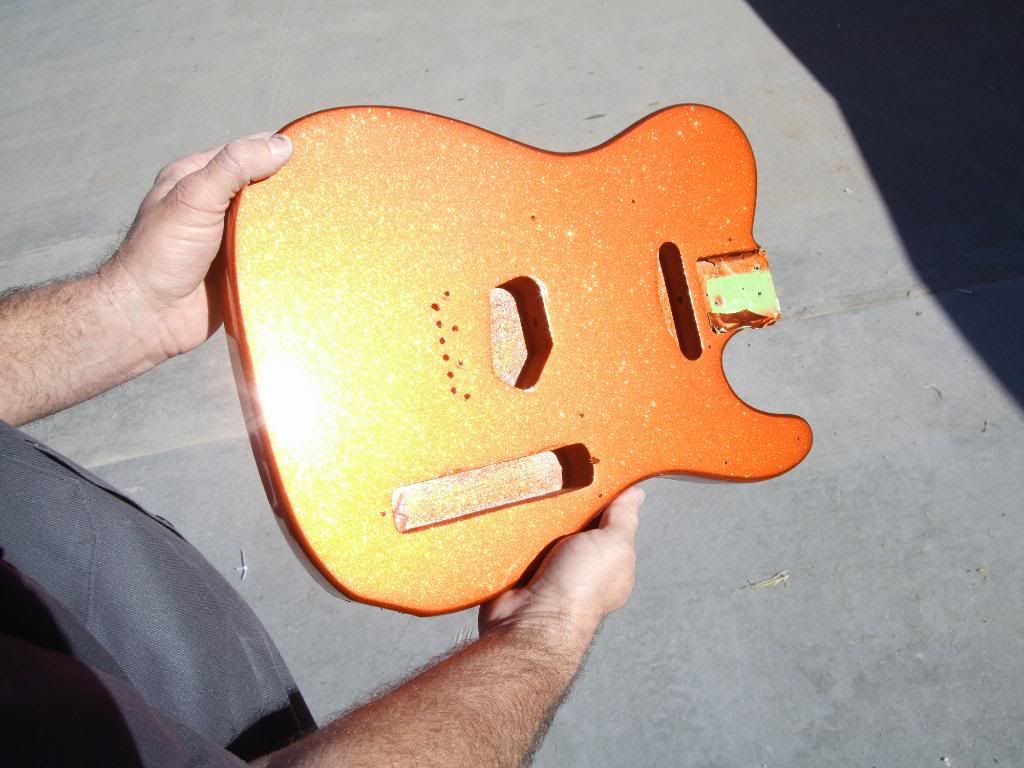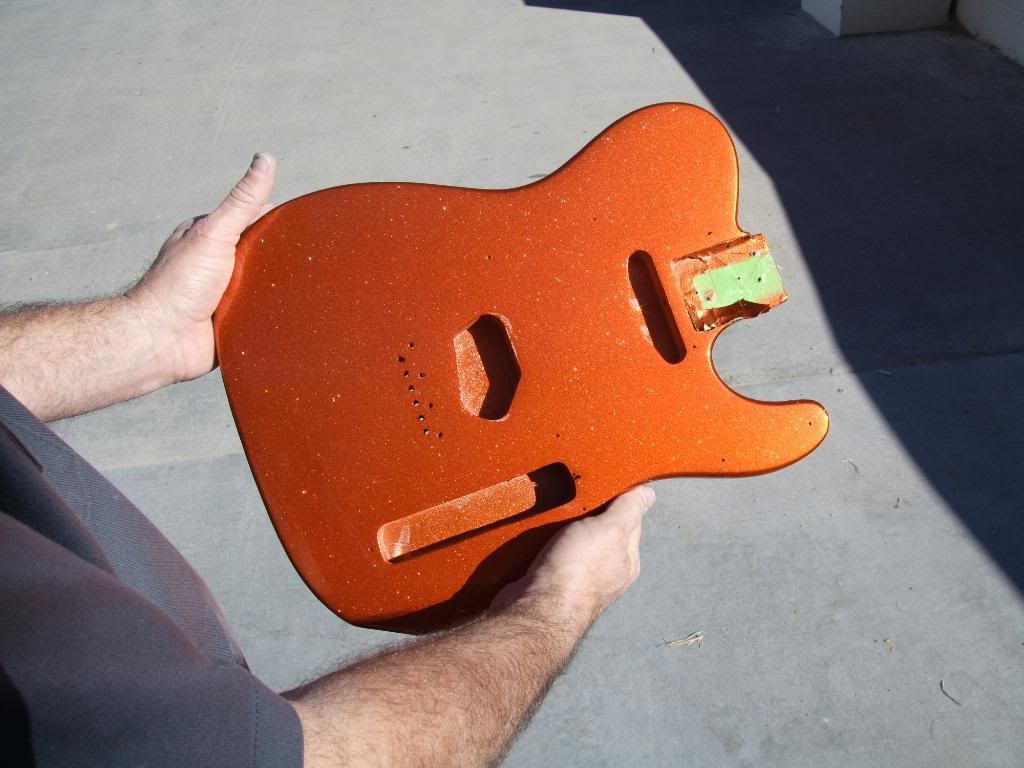-
Posts
973 -
Joined
-
Last visited
Content Type
Profiles
News and Information
Tutorials
Product Reviews
Supplier Listings
Articles
Guitar Of The Month
Links and Resources
Forums
Gallery
Downloads
Posts posted by syxxstring
-
-
Catalyzed polyester? Do you have any product names?
HOK and other automotive uro's have polyesters involved in some of their products. One factory rep told me the poly in polyurethane is polyesther.
-
Probably not gonna happen my friend. If you go all the way to the sealer you will loose the burst. I don't know how you keep the burst and loose the clear, Fender seems to be combining it into a single stage process these days. At least that's been my experience on some refinishes I've done.
-
The still disovable thing is one of the reasons I don't agree with everyones love of Nitro. That's why you hear horror stories of vintage 100k guitars ruined by a strap, chord, stand etc... I still not fully cured 50 years later. The only advantage is the relic thing and minor repair advantages. Far outweighed by the disadvantages and incredibly long curing times.
-
It goes on better with a gun I can tell you that for sure.
As far as distance etc... Read their instructions.
HOK's cosmic chrome is lot less fussy, but requires a spray gun.
The Alsa rep the demonstrated their chrome to me just lightly and quickly dusted it on.
-
I'm pretty sure Lacquer thinner is the solvent for lacquer.
-
I'm going to give a standard answer here and say read the manufacturers information for the paint you are going to use. It will tell you to sand to a specific grit and clean in a certain way. You probably are scuffing with a red or grey scotchbrite, or sanding in the neighborhood of 400 grit. This assumes you are not dealing with a damaged or worn surface.
-
As for thinner mixture, that will depend on your product. Follow the tech sheets, especially if they have information for a conventional gun.
Adjusting the fan should be possible, you should have 2 controls up top on the gun one is fluid the other is the fan size. If you have a third one it is for the air, leave it wide open and adjust either using a regulator at the gun or air compressor.
For your set up I'm not sure what to adjust how, since I think for that stile gun you may have to adjust the fan or fluid control buy the viscosity of your material.
One thing to note a conventional style gun transfers about 50% of what you put through it to the surface you are painting. In comparison HVLP guns are about 80%, and some of the newer LVLP guns are even more efficient. What that means is a HVLP setup will pay for itself if you paint a lot and create a lot less overspray to clean up. If you don't spray a lot or use cheap material it may not matter to you, seeing as my clears and paints can run up to $200 a gallon...
-
Give them a call, they have a help number on the can. I've talked to some of their tech guys, the are helpful and friendly.
-
I just took a class with House of Kolors Technical instructor, the mighty and powerful Brian Lynch. He's the guy the rockstar painters go to for help, advice, and working out paint plans. He has worked consulted for Trick My Truck, Monster Garage, and countless show cars.
He painted a guitar for me in the class with HOK's Orion Silver under a Orange Candied Metajewels, then cleared it in an open conference room(don't ask). Zero orange peel, better than factory from the big guys. It brings the bling.
A good gun helps, but a cheap one will do if it has the right tip size, sprays correctly, and is adjusted right. Also think about your air supply and how you regulate and filter it. With a cheater valve and not a regulator on the gun you will not have a constant air supply.
The old guns are a mystery to me, I only use and have read up on the HVLP guns. They are more efficient and create less overspray.
Here was his take on orange peel:(some of this applies more to 2k urethanes, mostly its universal)
1. Read, understand, and follow the tech sheets.
2. Spray a test pattern to make sure your gun is dialed in. Right fan size, right atomization, equal amounts of paint throughout the pattern, and a nice oval shape. Google it I'm sure you can find material on dialing in a spray gun. I bet DeVilbiss has it on their site.
3. Next you need to maintain proper distance with the gun. This will be in your guns manual. Typically my guns instructions say 6" away for a 6" fan. A guitar he recomended a 4-5" fan.
4. Next its all about laying down a single flowing coat of paint. Don't spray paint till it flows, spray so it will flow. This means a quick application of an even coat of paint. Your tendancy will be to put on too much paint. A guitar takes about 2 minutes to spray a coat. T
5. Leave it alone until it flashes. Don't speed it up, flash time is where the solvent gets out of the way so the molecules in the paint can lay down in a nice smooth pattern. This means don't blow it dry with the gun, don't super heat it, just don't. I know production shops do this on cars, but look at the peal they leave, because they are trying to emulate factory quality.(or lack there of) You are aiming for custom quality, so time matters less than quality.
6. Recoat within the proper times from your paint, per the tech sheets.
7. Buff lightly, enjoy. Don't forget to clean your gun.
Hope this helps, I know it helps me to type it out and think about the process.
*edit*
Finally, uploaded my pictures. This is straight off his gun.



-
I would just use thier primer. That is what HOK's tech rep showed me to do.
-
Don't know what to tell you there. I have about 40 quarts of Autoair and 4 different airbrushes.
Edit, thought about it.
Signpainters One Shot if your not clearing over the art. House Of Kolor Striping paints if you are.
Either product can be used in the other situation with additives.
-
Use masking vinyl. Its specifically designed for, well masking.
It is low tack so the solvents won't cause you problems in removal or react with your cured substrate.
Usually cheaper too.
-
You shouldn't have any bubbles. Bubbles usually indicate contamination.
Runs are avoidable, thin light coats keep the can moving.
-
I'm not sure on the Nitro, but Autoair Colors work well. I mostly use automotive paints and get supplies exclusively from CoatAirbrush.com. I know other airbrush artist that reduce regular art paints but have never tried this myself.
-
2k Urethanes, common automotive clears. Depending on the paint your using for the artworks maybe a furniture poly.
Nitro is old technology that the paint industry gave up on because the finish is not as durable or uv resistant as the stuff we use today as well as the enviormental concerns.
-
As far as the primer.
It is your base for a paint job, typically the chemicals in primer are designed to provide better adhesion to whatevers underneath and a surface for the other components solvents to bite into. So yes I would use a primer.
I would sand to whatever the primer tells you to use over the existing finish. Then sand the primer with whatever the primer or next stage of your paint plan tells you.
I know there's a bunch of people the like to make up stuff about how paints work because they think they know more than the chemists that really test this stuff. But it really is as simple as following the directions that the manufacturers directions.
I recently spent a week learning from a House of Kolor trainer/product tester. He has a lab with things like an electron microscope and uv baths. This way they can really watch whats happening with paint. Just watching paint dry with simple tools and our eyes was quite revealing.
As far as coats, here's the best thing you can do spray in light coats following the directions for recoat times. The first thing we were told in the HOK paint class is you put paint on too heavy. Then we painted something and saw it. Light coats allow the solvents to do their job of reordering the molecules of finish as they escape. Light coats will accomidate letting the paint work with minimal hastle from blotching, running and orange peel.
-
Do it on the clear, that way if there's a mistake it will be easier to fix. But you don't want to polish the clear first you need to leave it scuffed so the paint can stick.
Ymmv but I would stick with modern clears unless you want to do the aged/relic'd thing.
-
Keep in mind most of todays "oil" finishs have a varnish in them, at least according to Flexner's book.
-
Remember what goes into a custom finish:
Primer
Sealer
Paint
Clear
Plus the prep work, and post finish work. $400 is reasonable for this kind of work unless you can find a custom painter that will work for next to nothing, the painter will have at least a few hours into it. I've taken airbrush classes from a guy that does a lot of Jackson's namm guitars and such, I doubt you'd get the finish that cheap going directly too him.
-
Using sign painters One Shot, you could do it with out reclearing or sanding. You might need to scuff for a large area, read their tech sheets.
-
It's the Kustom Kulture Lounge, hosted by Craig Fraiser. Who will ban, delete, and harass people at will. He keeps it pretty no nonsense around there, making it a favorite place of mine.
-
Not sure wht you are trying to say there black labb, but you are not providing any load in your scheme for the output transformer unless your missing a resistor in the equation.
-
What's really funny is Erie Dess is what HOK used to label the cans of marbelizer as.
I'm on another custom paint forum where a HOK tech explains how to do it.
Basically as stated.
Prime
Seal ( if you use black sealer there is no need for base coating)
Spray marbelizer
Swirl as you wish, that look is done with plastic
Spray transparent color layer(ie Candys)
Clear
I would stick with all HOK products for this if you can spray them safely. Coast Airbrush sells small quantity kits.
You can also marbelize with any color Auto Air paint.
-
For a gun, use a House Of Kolor primer Kp2cf , then their KoSeal black.
I was in a class all last week with HOK's tech instructor. He did a rock crawler with the stuff for the pro circuit and it lasted an entire season with no issues. Thats a little more abusive than what we put our gear through, unless you blow steaming transmission fluid all over your guitar.
I know a few other kustom painters that use it for their black. HOK's tech guy over there is named Owen, a really nice guy.



Fender Hot Rod Deluxe Texas Red
in Players Corner
Posted
You can definitley get into some of the Mesa combo's at that price.
As far as future value who knows? The market is weired and mostly celebrity driven.